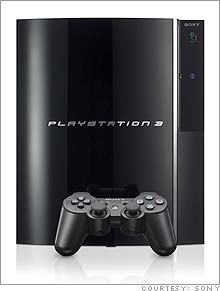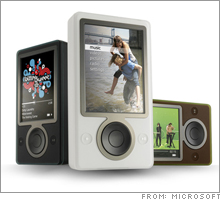November sales data gives Nintendo a 2-1 sales advantage over Sony.
NEW YORK (CNNMoney.com) -- You weren't imagining things. Finding a PlayStation 3 in November really was a Herculean task.
Sony (Charts) sold just 195,000 PS3 units in its first 13 days on shelves, according to analysts quoting preliminary numbers from The NPD Group, which tracks video game sales. That's well short of the 400,000 the company had projected. Nintendo's Wii console, another hot holiday item, sold 476,000 units - a more than 2-1 sales advantage.
 | | Sony's PS3 has been continually out of stock at most retailers. |
|
|
Microsoft's (Charts) Xbox 360, fueled by the critically praised new title "Gears of War," sold 511,000 units, which John Taylor of Arcadia said puts it on track for 2006 sales of roughly 4 million.
The real surprise of the month was the strong sale of handheld and legacy systems. The Nintendo DS, which was one of last year's hottest items, continues to sell extremely well. November saw sales of 920,000 for the device (Taylor's estimate for the month was just 650,000.) The Game Boy Advance, meanwhile, continues to sell well, with another 639,000 units sold.
Sony saw the PlayStation 2 continue to sell well, moving 663,000 units. And 413,000 PSPs (PlayStation Portable) were sold in November.
The NPD Group declined to provide the information, citing errors in "historical data" (which is typically used to provide comparisons to previous months and years). November 2006 data is correct, however.
Taylor said both Sony and Nintendo are actively working to get additional units on retail shelves. Sony, he said, is shipping roughly 75,000-100,000 units to the U.S. each week. He expects there to be 600,000-800,00 PS3s available in the U.S. by year's end.
Nintendo's strategy is slightly different.
"Retailers were told by Nintendo that there would be three major waves of product," said Taylor. "The first wave was at launch, then there was one immediately thereafter, which was in Nintendo's warehouse, and a final wave is due the week before Christmas. ... Retailers who had ads planned throughout the holidays, we heard, would get supply as well, but those are rifle shots instead of waves."
Game sales were stronger than expected in November. A report from Michael Pachter of Wedbush Morgan Securities quotes NPD software sales figures of $804 million. Of that, $363 million was spent on 'next generation' machines (which Pachter defines as the PS3, Wii, Xbox 360, DS and PSP).
Xbox 360 and DS sales led the charge.
Before the launch of the PS3 and Wii, many speculated Microsoft would benefit from the expected shortages. The theory went that consumers, frustrated by their inability to find a new Nintendo or Sony system, would pick up an Xbox 360 for loved ones.
Now, though, analysts aren't sure that is happening.
"The kicker for Microsoft is going to be the psychology of scarcity in a seasonal environment where people need to make a decision," he said. "It appears, based on these numbers, that they might be buying handheld systems instead." 
By Chris Morris, CNNMoney.com staff writer





